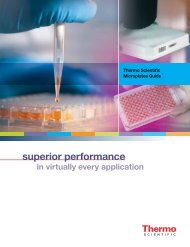PeloBiotech
You also want an ePaper? Increase the reach of your titles
YUMPU automatically turns print PDFs into web optimized ePapers that Google loves.
www.pelobiotech.com<br />
4. Detailed Donor Information:<br />
We offer in-depth donor information, including gender, age, ethnicity, BMI, cause of death, smoking and<br />
alcohol history, HLA typing, serology data, and past medical records, allowing you to choose cells that align<br />
with your specific research requirements.<br />
5. Versatility in Testing:<br />
Our hepatocytes are not only plateable but also 3D tested, offering versatility for various research applications,<br />
from monolayer cultures to complex 3D experiments. Please contact us for detailed information about 3D cell<br />
culture to find out how we can help you better.<br />
Explore the intricate and vital role of hepatocytes in the human body's metabolism of xenobiotics and<br />
drugs by reading our article on our News section on website for in-depth information. Just scan the QR<br />
code for direct access.<br />
Scan the QR code to see our full cell list.<br />
Fibroblasts contribute to studies on liver fibrosis and tissue repair, shedding light on the cellular dynamics in hepatic<br />
wound healing. Kupffer cells, as liver-resident macrophages, are key players in immune response studies, inflammation,<br />
and liver pathophysiology. Stellate cells, involved in liver fibrosis, are integral for investigations into hepatic stellate cell<br />
activation and its impact on liver health.<br />
Hematopoietic stem cells extracted from the liver provide a unique perspective on hematopoiesis and immune cell<br />
development. Non-parenchymal cells, comprising various liver cell types, enable comprehensive studies encompassing<br />
liver microenvironment, cell-to-cell interactions, and organ-specific responses to therapeutic interventions.<br />
Stellate cells, also known as hepatic stellate cells, play a significant role in liver fibrosis, and their activation is a key event<br />
in the development of fibrosis. They are involved in the resolution of liver injury and are the primary storage site for<br />
retinoids in the liver. Additionally, stellate cells have been shown to express desmin, suggesting their contribution to the<br />
stellate cell population. Furthermore, stellate cells have been implicated in the regulation of liver fibrosis and have been<br />
shown to produce increased levels of inflammatory mediators, contributing to the fibrogenic program of liver cells. They<br />
are also involved in the turnover of extracellular matrix, and their activation is a major pathogenic determinant of liver<br />
fibrosis. Moreover, stellate cells have been shown to be coupled to one another by gap junctions, indicating their role in<br />
intercellular communication. Additionally, stellate cells have been studied in the context of liver regeneration, and their<br />
inhibition has been shown to reduce renal fibrosis.<br />
Kupffer cells, which are liver-resident macrophages, play a crucial role in liver homeostasis, inflammation, and immune<br />
regulation. They have been implicated in the pathogenesis of wound healing and fibrosis in the liver. Kupffer cells have<br />
been shown to be involved in the regulation of stellate cell activation and susceptibility to fibrotic liver disease.<br />
Sinusoidal microvascular endothelial cells, which line the hepatic sinusoids, have been studied for their involvement in<br />
liver fibrogenesis and the resolution of liver injury. They have been shown to be regulated by vitamin A and retinoic acid<br />
signaling, which are essential for their development and liver morphogenesis. Endothelin antagonism has been studied in<br />
the context of hepatic fibrosis, implicating endothelial cells in the pathogenesis of wound healing and fibrosis.<br />
20
















